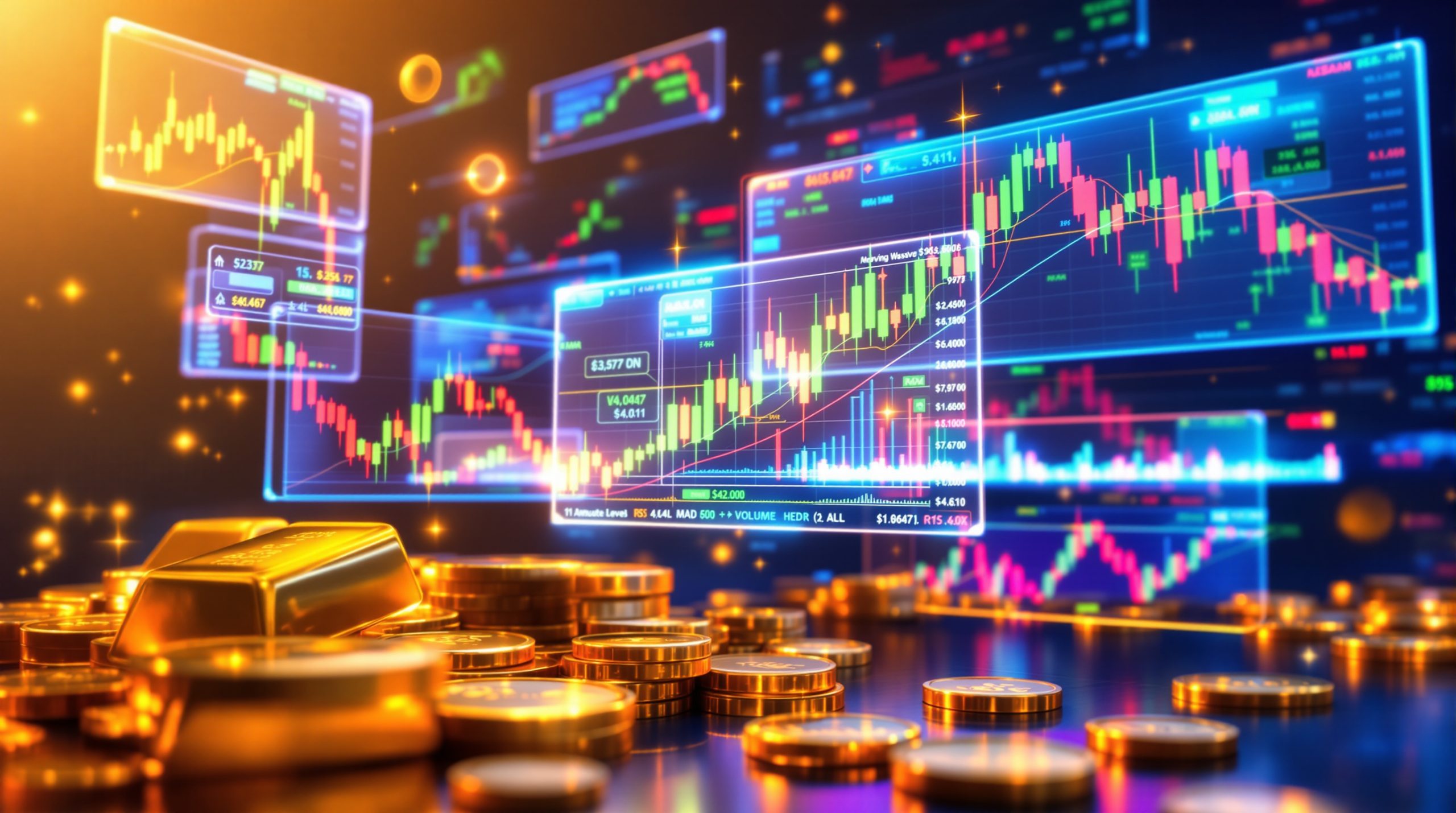Copper Market Recovery: Understanding the Recent Price Movements and Trade Outlook
Copper prices have demonstrated remarkable resilience in recent trading sessions, rebounding strongly after experiencing significant volatility. The industrial metal, often called "Dr. Copper" for its ability to predict economic trends, has captured the attention of traders, investors, and economic analysts alike as it navigates a complex landscape of trade tensions, supply constraints, and shifting demand patterns.
The recovery trajectory reflects both immediate market reactions to geopolitical developments and deeper structural factors that continue to support copper's long-term outlook. As infrastructure spending increases globally and the green energy transition accelerates, copper edges higher after slump as US talks up outlook on trade while fundamental demand drivers remain robust despite short-term fluctuations.
What Caused the Recent Copper Price Volatility?
The Significant Price Drop and Recovery
Copper futures experienced their sharpest one-day decline in nearly a month, falling over 3% on Wednesday as traders responded to mounting concerns about global demand conditions. This dramatic sell-off pushed prices to multi-week lows, triggering technical selling pressure across major exchanges.
However, the market demonstrated remarkable resilience in subsequent sessions, with prices staging a significant comeback toward $9,150 per ton on the London Metal Exchange (LME). This V-shaped recovery pattern highlights copper's underlying strength amid challenging market dynamics insights.
Market analysts note that such rapid price reversals typically indicate the presence of strategic buyers who view temporary downturns as opportunities to build positions at more favorable entry points. Physical buyers, particularly from Asia, have reportedly increased their purchasing activity during price dips, providing support to the broader market.
Macroeconomic Factors Behind the Slump
Multiple converging factors contributed to copper's recent price pressure:
-
Trade tensions: Escalating rhetoric between major economies created uncertainty about future demand scenarios, particularly affecting industrial commodities sensitive to manufacturing activity.
-
Manufacturing concerns: Recent economic data from key consuming regions showed potential slowdowns in manufacturing activity, particularly in sectors with high copper intensity.
-
Inventory dynamics: Fluctuating warehouse stocks across major metal exchanges contributed to price volatility, with unexpected inventory builds pressuring prices.
-
Institutional positioning: Significant profit-taking by hedge funds and institutional investors following previous price rallies accelerated the downward momentum as long positions were unwound.
Technical analysts identified that copper's breach of key support levels around $9,200 triggered momentum-based selling algorithms, temporarily overwhelming buy-side interest before value buyers emerged at lower levels.
How Are US-China Trade Relations Affecting Copper Markets?
Recent Positive Signals from US Officials
Copper's recent recovery gained significant momentum following optimistic statements from high-level U.S. officials regarding trade negotiations with China. President Trump expressed a notably positive outlook, stating there's a "very good chance" of reaching a comprehensive trade agreement with China.
This sentiment was reinforced by U.S. Trade Representative Jamieson Greer, who indicated that an announcement regarding initial trade agreements could be imminent. Greer's comments carried particular weight given his direct involvement in the negotiation process.
A key aspect of these communications was the consistent emphasis that any agreement must ultimately favor U.S. interests. This position reflects the complex balancing act negotiators face when attempting to resolve structural trade issues while maintaining political support domestically.
Historical analysis suggests that even incremental progress in trade negotiations typically delivers disproportionate benefits to industrial metals markets, as they reduce uncertainty and improve business confidence in manufacturing and construction sectors.
Impact of Trade Rhetoric on Metal Prices
Copper demonstrates exceptional sensitivity to geopolitical developments and trade policy shifts for several key reasons:
-
Forward-looking pricing: Copper traders price assets based on anticipated demand scenarios 3-6 months ahead, making the market highly responsive to policy signals that might affect future industrial activity.
-
Historical correlation: Analysis of previous trade negotiation cycles reveals a consistent pattern where positive diplomatic statements typically trigger 2-4% price movements within 48-hour windows.
-
Sentiment multipliers: Investor sentiment in copper markets can shift rapidly based on diplomatic statements, with algorithmic trading systems amplifying these movements through momentum-following strategies.
-
Scenario pricing: Market participants continuously reassess probability-weighted outcomes under various trade scenarios, adjusting risk premiums accordingly.
Trading volumes typically surge during periods of active trade discussions, reflecting heightened market engagement as participants reposition based on evolving diplomatic signals. This creates both challenges and opportunities for strategic investors able to differentiate between short-term noise and fundamental trend shifts.
Why Is Copper Considered a Barometer for Economic Health?
Copper's Role as an Economic Indicator
Copper's unique status as an economic indicator stems from its pervasive use across multiple sectors of the global economy:
-
Industrial ubiquity: Copper's excellent electrical conductivity, thermal properties, and corrosion resistance make it irreplaceable in numerous industrial applications.
-
GDP correlation: Historical data reveals a remarkably consistent correlation between copper price dynamics and global GDP growth, with price movements often preceding official economic data by 3-6 months.
-
Infrastructure sensitivity: Major infrastructure initiatives typically require substantial copper inputs, making the metal highly responsive to fiscal stimulus programs and public works projects.
-
Economic cycle indicator: Copper price trends have demonstrated leading indicator properties for broader economic cycles, earning it the nickname "Dr. Copper" for its diagnostic capabilities regarding economic health.
Economists frequently incorporate copper price movements into composite leading indicators designed to forecast economic turning points. The metal's price discovery mechanism, which integrates inputs from diverse global market participants, effectively functions as a real-time economic barometer.
Key Demand Sectors Driving Price Movements
Several critical sectors drive copper demand dynamics and influence price movements:
-
Construction industry: Building activity accounts for approximately 28% of global copper consumption, with wiring, plumbing, and structural applications representing major use cases. Current construction forecasts suggest 4.2% global growth in 2025.
-
Renewable energy: The ongoing energy transition is significantly increasing copper intensity in power systems. Solar and wind installations require approximately 5-6 times more copper per megawatt than traditional generation sources.
-
Electric vehicles: Each electric vehicle contains approximately 83 kg of copper, compared to 23 kg in conventional vehicles. With EV penetration rates accelerating globally, this sector represents a major growth driver.
-
Power infrastructure: Grid modernization initiatives and expansions require substantial copper inputs for transmission and distribution systems, with smart grid technologies further increasing per-unit requirements.
"The ongoing electrification of transportation and energy systems represents the most significant structural demand driver for copper in over half a century. Unlike previous commodity cycles, this shift is policy-driven rather than purely economic, creating a fundamentally different demand trajectory." – Industry analysis from a major mining company's quarterly report.
What Are the Current Supply-Demand Fundamentals?
Global Production Landscape
The copper production landscape continues to evolve in response to both geological and geopolitical factors:
-
Major producing regions: Chile remains the dominant copper producer, accounting for approximately 28% of global output, followed by Peru (10%), China (8%), and the Democratic Republic of Congo (DRC) with rapidly growing production approaching 8% of global supply.
-
Mine disruptions: Supply chains have faced significant challenges, with labor disputes, technical issues, and water availability constraints affecting multiple major operations. Chilean operations have experienced approximately 7% below-target production in 2025.
-
Refined production: Global refined copper production capacity utilization rates currently stand around 82%, reflecting both technical constraints and strategic production decisions by major producers.
-
Project pipeline: The exploration and development pipeline for new copper projects has experienced significant underinvestment over the past decade, with capital expenditure approximately 35% below replacement requirements, creating potential medium-term supply constraints.
Resource nationalism has emerged as an additional complicating factor, with producing countries increasingly seeking to capture greater economic value from their mineral resources through revised tax regimes, ownership requirements, and export restrictions. Understanding Codelco production insights provides valuable context for evaluating the Chilean market's influence.
Inventory Levels and Market Balance
Current inventory metrics provide important insights into immediate market conditions:
-
Exchange inventories: Warehouse stocks across the LME, COMEX, and Shanghai Futures Exchange have declined approximately 18% year-to-date, reaching levels that historically signal tight physical market conditions.
-
Consumption metrics: Current days-of-consumption coverage stands at approximately 3.9 days versus the five-year average of 6.2 days, indicating potential vulnerability to supply disruptions.
-
Regional imbalances: Significant price premiums have emerged in European markets where energy constraints have limited regional production, creating arbitrage opportunities for traders able to navigate logistical challenges.
-
Forward balance: Industry analysts project a modest market deficit of approximately 250,000 tonnes for the upcoming year, representing about 1% of global consumption.
The recent inventory drawdowns have occurred despite economic headwinds, suggesting either stronger-than-reported consumption or more significant supply constraints than publicly acknowledged. These divergences often precede significant price movements as the market adjusts to revised fundamental assessments.
How Do Tariffs Impact the Copper Supply Chain?
Direct and Indirect Effects of Trade Barriers
Tariff impacts ripple through the copper supply chain in complex ways that extend beyond immediate price effects:
-
Tariff structures: Raw materials often face different tariff treatment than semifinished or finished copper products, creating cascading effects through manufacturing chains and incentivizing specific processing locations.
-
Cost implications: Manufacturers using copper inputs face compressed margins when tariffs increase input costs that cannot be fully passed to end consumers, particularly in competitive finished goods markets.
-
Supply chain restructuring: Companies have increasingly invested in supply chain reorganization to mitigate tariff exposure, including shifting production locations, altering sourcing patterns, and creating redundant capacity.
-
Price premiums: Regional markets affected by trade restrictions typically develop physical delivery premiums above global benchmark prices, creating pricing complexity for contract negotiations.
The administrative burden of navigating complex tariff structures represents an additional "hidden tax" on the industry, with compliance costs disproportionately affecting smaller market participants with limited regulatory resources. Companies are increasingly focused on navigating copper concentrates markets amid these challenges.
Regional Market Distortions
Trade policies have created notable regional market distortions:
-
Hub differentials: Price differentials between major trading hubs (Shanghai, London, New York) have widened beyond historical norms, exceeding traditional arbitrage costs by 2-3%.
-
Logistics adaptation: Shipping patterns and material flows have adjusted to circumvent the most punitive tariff structures, sometimes resulting in indirect routing that increases carbon footprints and transportation costs.
-
Material substitution: In applications where technical specifications permit, manufacturers have increased experimentation with aluminum, aluminum-copper alloys, and other alternatives to reduce exposure to copper price volatility.
-
Strategic stockpiling: Evidence suggests increased inventory accumulation ahead of anticipated tariff implementations, creating temporary demand surges followed by consumption voids.
These distortions create both risks and opportunities for market participants with the analytical capabilities to identify and capitalize on structural inefficiencies created by policy interventions.
What Are Analysts Forecasting for Copper Prices?
Short-Term Price Projections
Technical and fundamental analysts offer diverse perspectives on copper's near-term trajectory:
-
Technical indicators: Recent price action has established support at $8,950 and resistance at $9,350, with momentum indicators showing positive divergence despite price weakness. The 50-day moving average currently intersects near $9,080, providing a key reference point.
-
Momentum assessment: The Relative Strength Index (RSI) has rebounded from oversold territory, suggesting potential for continued upward momentum if fundamental support remains intact.
-
Options positioning: The put-call ratio for copper options has declined from 1.8 to 1.3 over the past two weeks, indicating improving sentiment among derivatives traders and reduced demand for downside protection.
-
Catalysts ahead: Key economic data releases, central bank communications, and trade negotiation developments represent potential triggers for near-term price movements, with Chinese manufacturing PMI data carrying particular significance.
Most trading desk forecasts cluster in the $9,100-9,500 range for end-of-quarter prices, suggesting modest upside from current levels assuming no significant deterioration in macroeconomic conditions.
Long-Term Outlook Factors
Structural factors shape copper's longer-term price trajectory:
-
Infrastructure initiatives: Major infrastructure spending programs across both developed and emerging economies are expected to sustain demand growth of approximately 2.8% annually through 2027.
-
Energy transition: The accelerating shift toward renewable energy and electrification is forecast to require an additional 4.5 million tonnes of copper annually by 2030 compared to 2020 baseline consumption.
-
Mining investment: Capital expenditure cycles in copper mining typically span 5-7 years from investment decision to production, with current project pipelines insufficient to meet projected demand growth beyond 2027.
-
Technological factors: Advancements in recycling technology and material efficiency are partially offsetting increased consumption, though these gains remain insufficient to fundamentally alter the supply-demand balance.
Investment banks broadly project average copper prices rising to the $10,000-11,000 range by 2027, reflecting anticipated structural deficits as demand growth outpaces supply expansion capabilities. The global copper outlook typically incorporates assumption sets regarding global economic growth, timing of energy transition initiatives, and success rates of currently planned mining projects.
How Are Traders Positioning in the Copper Market?
Institutional Investment Trends
Institutional positioning provides valuable insights into market expectations:
-
Hedge fund activity: Commitment of Traders reports indicate that managed money positions have reduced net long exposure by approximately 15% during the recent price volatility, though they remain modestly net long in historical context.
-
ETF flows: Exchange-traded products tracking copper prices have experienced modest inflows despite price weakness, suggesting longer-term investors view current levels as attractive entry points.
-
Commercial/producer hedging: Producer hedging has decreased in recent months, potentially indicating confidence in price stability or upside from current levels among those with direct market exposure.
-
Options market: The implied volatility term structure has flattened, with near-term volatility premiums decreasing relative to longer-dated options, suggesting reduced expectations for immediate price shocks.
The divergence between speculative positioning (more cautious) and commercial positioning (less hedged) creates an interesting market dynamic that often precedes directional price movements as these imbalances resolve.
Risk Management Strategies
Market participants employ various strategies to navigate the current uncertain environment:
-
Producer approaches: Mining companies have increased their unhedged exposure compared to historical norms, with average hedge ratios declining from 18% to approximately 11% of forward production over the past 18 months.
-
Consumer strategies: Industrial consumers have extended their average hedge duration from 4.2 to 6.1 months, locking in current prices for longer periods given concerns about future supply constraints.
-
Correlation trading: The traditional relationship between copper prices and the USD/CNY exchange rate has weakened, reducing the effectiveness of currency-based proxy hedges for copper exposure.
-
Calendar spreads: The forward curve structure has flattened considerably, reducing the cost of carry for long positions and changing the economics of roll-yield strategies for investors with longer time horizons.
Sophisticated market participants increasingly utilize options structures rather than outright futures positions to express directional views while maintaining defined risk parameters in the current volatile environment.
What Other Metals Are Being Affected by Similar Factors?
Comparative Performance Across Base Metals
Base metals have demonstrated varying degrees of sensitivity to the current market environment:
-
Aluminum: Prices have shown greater resilience than copper during recent volatility, supported by production constraints related to energy costs in Europe and environmental policies in China. Aluminum has outperformed copper by approximately 3.5% over the past month.
-
Zinc: Supply disruptions in zinc mining and smelting have created more significant inventory drawdowns than in copper markets, with global visible inventories covering just 3.2 days of consumption versus historical averages near 8 days.
-
Nickel: Extreme price volatility earlier this year has reduced speculative participation in nickel markets, creating potentially thinner liquidity conditions and vulnerability to sudden price movements.
-
Lead: Has demonstrated the least correlation to trade headlines among major base metals, reflecting its unique demand drivers focused on battery replacement rather than new economic activity.
These divergent performance patterns create potential relative value opportunities for investors able to identify metals with fundamentals that may be temporarily obscured by broader market narratives.
Precious Metals Relationship
The relationship between industrial and precious metals offers additional insights:
-
Gold dynamics: Gold has functioned effectively as a portfolio hedge during periods of copper weakness, with negative correlation strengthening during risk-off episodes. This relationship has made gold an effective tactical hedge for copper positions.
-
Silver's dual nature: Silver's industrial applications (approximately 50% of demand) create greater correlation with copper than gold during normal market conditions, but this relationship weakens during periods of financial market stress.
-
Portfolio positioning: Institutional investors have increasingly utilized pairs trading approaches across metal complexes, simultaneously expressing views on economic growth (via industrial metals) and monetary policy (via precious metals).
-
Correlation stability: The copper-gold ratio has historically provided signals about broader risk sentiment, with the current ratio suggesting relatively balanced growth and inflation expectations.
Diversification across metal categories has demonstrated superior risk-adjusted returns compared to single-metal exposures, particularly
Want to Identify the Next Major ASX Mineral Discovery?
Discovery Alert's proprietary Discovery IQ model provides real-time notifications when significant mineral discoveries are announced on the ASX, turning complex data into actionable investment insights. Explore our discoveries page to see how historic mineral discoveries have generated exceptional returns and start your 30-day free trial today.




